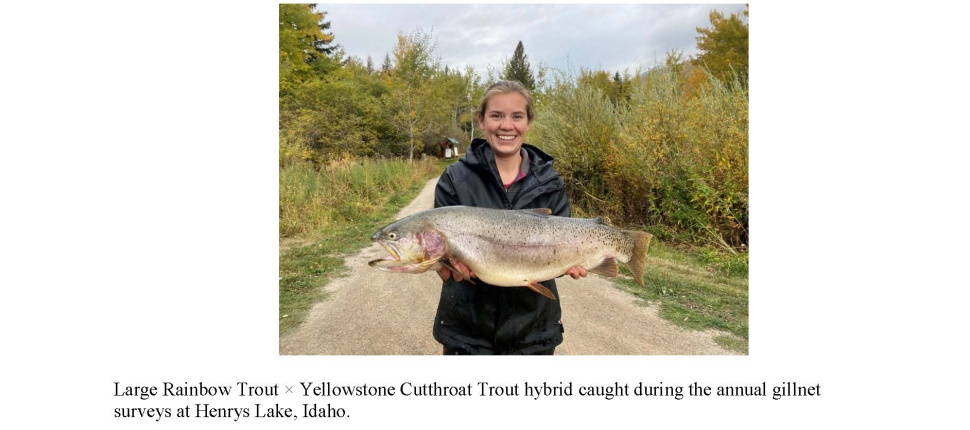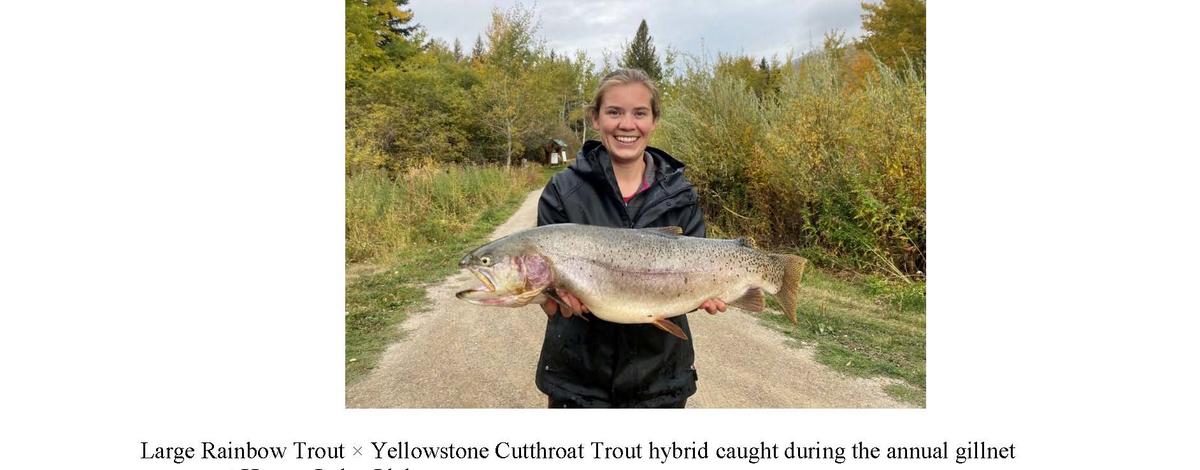
Henrys Lake is a renowned trophy trout fishery that is managed for rainbow trout and Yellowstone cutthroat trout hybrids, Yellowstone cutthroat trout, and brook trout. Yellowstone cutthroat trout is a popular sport fish and is native to Henrys Lake and the Greater Yellowstone Ecosystem. Unfortunately, Yellowstone cutthroat trout have experienced substantial population declines caused by nonnative species and reduced habitat quality and quantity. As a result, conserving native Yellowstone cutthroat trout in Henrys Lake is a high priority for resource managers.

Yellowstone cutthroat trout are considered particularly vulnerable to the negative effects of nonnative species. In 1993, nonnative Utah chubs were first documented in Henrys Lake and have become abundant over the past three decades. For example, catch rates of Utah chub during the annual gillnet surveys increased 16-fold from 2002 to 2018. The influence of Utah chub on Yellowstone cutthroat trout is largely unknown, but they have typically had a sizeable negative effect on salmonids in systems where they have been introduced. Utah chub is frequently considered a nuisance species and is not targeted by anglers, and can often compete with popular sport fishes for food.
Given the importance of the Henrys Lake fishery, additional information was needed regarding the factors influencing the Yellowstone cutthroat trout population and potential interactions with Utah chub. Therefore, Idaho Fish and Game partnered with the Idaho Cooperative Fish and Wildlife Research Unit and the University of Idaho to conduct research at Henrys Lake from 2019 to 2021.
The research goals were to:
- Describe long-term trends in Yellowstone cutthroat trout population characteristics and identify factors influencing catch rates and growth in Henrys Lake.
- Describe the movement and habitat use of Yellowstone cutthroat trout and Utah chub in Henrys Lake. Collectively, results from this research will be used to inform management and conservation decisions for Yellowstone cutthroat trout and Henrys Lake.
Yellowstone Cutthroat Trout Population Trends
Fish populations have been monitored in Henrys Lake since 1970 and these historical data can provide valuable insight on long-term changes in population dynamics. The number of Yellowstone cutthroat crout caught in the annual population surveys varied from 1.5 to 15.4 Cutthroat per net night during the 2002 to 2020 sampling period, but no consistent patterns were identified (Figure 1).

In addition to catch data, researchers also collected “hard structures” from fish that were used for aging. Hard structures, such as scales and otoliths, form rings that mark annual growth similar to tree rings (Figure 2). Biologists can estimate age by counting the total number of rings and evaluate yearly growth by measuring the distance between rings (increments). Growth of the hard structure is proportional to the growth of the fish and the increments can be used to estimate lengths at previous ages (i.e., back-calculated lengths).

We compared back-calculated lengths at age of Yellowstone cutthroat trout across decades (Figure 3). Two interesting patterns were revealed by this comparison. First, we noticed increased variation in size at age through time. The second pattern is that cutthroat trout in the most recent two decades are slightly larger on average than Yellowstone cutthroat trout in the past.

Researchers further evaluated growth to understand what environmental or biological factors may be influencing growth of Yellowstone cutthroat trout in Henrys Lake. Yellowstone cutthroat troutt grew faster when Utah chub and brook trout abundances were low compared to when Utah chub and brook trout abundances were high. The specific cause of slower growth is not known in Henrys Lake, but it is possible that Utah chub and (or) brook trout compete with Yellowstone cutthroat trout for food or habitat resources. Although some negative growth relationships were identified, Yellowstone cutthroat trout growth in recent decades is as fast as or faster than earlier time periods. Results from this research suggest that major changes in Yellowstone cutthroat trout population dynamics are not evident over the last 50 years.
Movement and habitat use of native Yellowstone cutthroat trout and nonnative Utah chub
Yellowstone cutthroat trout (top photo ) and Utah chub (middle) were surgically implanted with radio transmitters and released so their movements could be tracked. Scientists used an antenna on a boat or plane (bottom) to detect tagged fish.



Researchers also radio-tagged 94 Yellowstone Cutthroat Trout and 95 Utah chub in spring 2019 and 2020 to better understand potential interactions between Yellowstone cutthroat trout and UTC in Henrys Lake. Fish were located via mobile tracking and fixed receivers from June to December, 2019 and 2020.
In June of both years, Yellowstone cutthroat trout and cutthroat trout were concentrated near shore (Figure 4). As water temperatures increased in July, Utah chub moved into deeper water and Yellowstone cutthroat trout concentrated more in cold water sources like the mouth of Targhee Creek and Staley Springs. Utah chub were consistently observed schooled together (presumably for spawning) in July and August.
Schools of fish were documented near the Idaho Fish and Game hatchery, Henrys Lake State Park, and most frequently down the outlet towards the dam (Figure 4). Yellowstone cutthroat trout were detected in Duck, Howard, Targhee, and Timber creeks during the summer.
Trout are likely using the creeks as thermal refuge during warm summer temperatures. No Utah chub were detected in the tributaries. In September and October, both species were widely distributed throughout the lake. By late fall (November– December), Yellowstone Cutthroat Trout were located along the shoreline and Utah chub were detected in the middle of the lake.


Figure 4. Monthly distribution maps of Yellowstone Cutthroat Trout (top row in blue) and Utah Chub (bottom row in red) in Henrys Lake, Idaho (2019–2020). Individual fish locations are indicated by white circles. Shaded contours represent density of use from kernel density estimates. The darker shading indicates higher probability and lighter shade indicates low probability of use.

The Take-Home Message
The purpose of this research was to understand how nonnative Utah chub may have influenced native Yellowstone cutthroat trout in Henrys Lake, Idaho. Trends in population dynamics of Yellowstone cutthroat trout in Henrys Lake are encouraging. Catch rates have improved in the most recent surveys and were above management goals for Henrys Lake in 2020.
Although a negative relationships between Yellowstone cutthroat trout growth and the abundances of brook trout and Utah chub was identified, Yellowstone cutthroat trout are currently growing as fast as or faster than in the past. Movement and habitat data further support the assertion that Utah chub are not having a direct effect on the Yellowstone cutthroat trout population. Spatial distribution patterns and resource selection indicate minimal overlap between Yellowstone cutthroat trout and Utah chub.
Although the results do not indicate a population-level response of Yellowstone cutthroat trout to Utah chub, continued monitoring is critical because a response may emerge as Utah chub become more abundant. Additionally, water temperature appears to be an important factor in Yellowstone cutthroat trout behavior, but does not seem to be adversely affecting Yellowstone cutthroat trout growth or abundance. Changes in management at Henrys Lake do not seem necessary at this time.
Idaho Fish and Game personnel will continue to monitor the Utah chub population in Henrys Lake and potential responses of trout species to changing numbers of Utah chub. However, there are additional concerns facing Henrys Lake that also warrant investigation in the coming years.
Rates of natural reproduction (non-hatchery) for Yellowstone cutthroat trout in Henrys Lake are low compared to historical estimates. Fish and Game is using genetic techniques to monitor natural reproduction in the major tributaries of Henrys Lake and is actively pursuing opportunities for habitat restoration projects that increase fish access to quality spawning habitat. Keep an eye out for the summer Henrys Lake Quarterly Newsletter for more information on projects happening this year.

